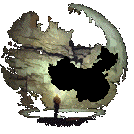
Grottes et karsts de Chine
Sur les traces de Xu Xiake
 Baishiyadong - 白石崖溶洞
Baishiyadong - 白石崖溶洞
Détail15/01/2025 13:21:07
Autres noms : Grotte de la falaise blanche
Province, Préfecture, District :
Gansu 甘肃省, Gannan Zangzu Zizhizhou 甘南藏族, Xiahe
Latitude Nord - Longitude Est :
35.448437 - 102.570361
Altitude (m) : 3280
Développement (m) : 1 000
Profondeur (m) :
Profondeur - / + (m) : 0 /
Volume (m3) :
Carte
Description 1
Description
白石崖溶洞 (Baishiya Karst Cave) is actually a karst cave, and it is possible to visit the cave guided by a monk. As far as we know this visit is not for the faint-hearted, there are numerous steep parts, rickety iron ladders and no light. You must definitely bring your own equipment as the guide will have only a single lamp and provide no equipment at all. If you are not able or willing to do some climbing you will have problems. Actually the way to the cave is quite difficult too. It is located in a remote part of Gansu Province, on a mountainside at an elevation of 3,280 m asl.
The cave is located on the southern side of Dalijiashan Mountain, at the mouth of the Jiangla River. The cave portal os 20m wide and 10m high and opens at the foot of a cliff. Facing south, with drinking water nearby and a great view, it was of great strategic value. It's easy to understand why the Deniosovans frequented the place, Later it became a Tibetan Buddhist sanctuary which belongs to Baishiya Temple, and was frequented by monks for meditation. It is said to be a former abode of Padmasambhava and the bodhisattva Tara. Tibetan Buddhists pilgrim to the cave and some time ago it became a tourist attraction. It was even visited by the 10th Panchen Lama in 1982. According to legend, the cave is connected to Xunhua County in Qinghai province, which is more than 50 km away. The actual length is only about 1 km. The monks normally use only the entrance for meditation, but it seems they are willing to show their cave to visitors.
We actually would not have listed the cave for its cave trekking tours, which are probably better called caving tours. We listed it for the archaeological importance of the site. The cave on a steep cliff face high up in the Himalayas was visited by humans for at least 160,000 years, which is quite impressive. Wikipedia calls this a "low-oxygen environment", but the site contained the earliest hominin fossil found on the Tibetan Plateau. The Xiahe mandible is the first confirmed discovery of a Denisovan fossil outside of CaveDenisova Cave. It was discovered in 1980 by a Tibetan monk who was meditating in the cave. He passed the fossil to Jigme Tenpe Wangchug, the sixth living Buddha of Gongtangcang, who donated it to Lanzhou University. But the researchers at the university did not know how to classify it, because it was so unusual. It took decades until finally Chen Fahu and Zhang Dongju began studying the cave. Finally, the cave was archaeologically examined and excavated in 2018.
A great discovery was made in 2019 when a fragment of jawbone was excavated. The Xiahe mandible was examined more closely, and a calcareous crust on the mandible was determined to be about 165,000 years old by uranium-thorium dating. Material from the teeth was analyzed and the protein analysis.showed that the Xiahe specimen belonged to a population that was closely related to the Denisovan specimens from Denisova Cave. This was the first time an ancient hominin was successfully identified using protein analysis.
[Jochen Duckeck]
Source : https://www.showcaves.com/english/cn/caves/Baishiya.html
Analyse :
3150 caractères - Lu 234 Fois
Bibliographie 0
Images 0
Topographie 0
Expédition 0
Recherche